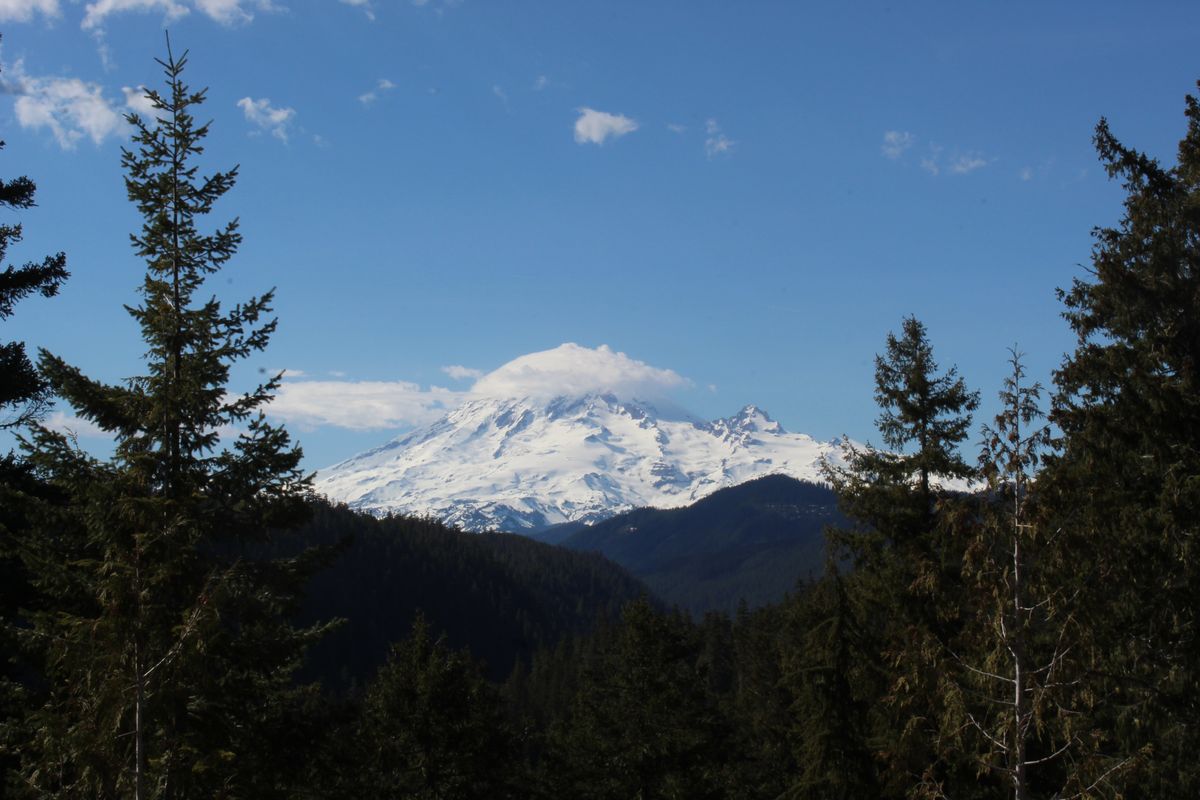Waterfalls, not wildflowers are Mt. Rainier National Park’s main springtime attraction

ASHFORD, Wash. – A thin layer of clouds hung over Mount Rainier on a bright sunny day in late April, serving a reminder to onlookers the surrounding park isn’t ready to be seen in full.
Sunday drivers and shuttle buses packed with tourists may have been disappointed by the peak’s veil. They’re among more than 2 million annual visitors to Mount Rainier National Park that will be greeted by a different experience depending on the time of year.
Springtime at the park can be best enjoyed off a paved trail.
Snow is melting and life awaking around the dormant volcano – known as Tahoma to the region’s Indigenous peoples. Glacial rivers rush past icy mountainsides, giving hikers a chance to see them at their fullest.
The southwestern Nisqually entrance and nearby town of Ashford, Washington, will be bustling when the mountain’s wildflowers bloom in late July to early August. There was a different scene on April 30.
With little wait, drivers passed through the entrance on a quiet, cloud-covered Sunday with mild temperatures.
The drive on Paradise Road to the Henry Jackson Visitor Center takes 40 minutes. That’s where the road ends early in the year and towering walls of snow remain for snowshoe hikers at the Vista Trailhead.
Along the ascent , visitors can find several trails fit for hiking boots.
First stop on Paradise Road is Kautz Creek and the accompanying trailhead.
It’s a short walk to a scenic viewpoint of the peak. On this day, a nearby Stellar’s jay knows better. He mocked those who wandered over for a glimpse of the mountain, only to be met with cloudy skies.
Kautz Creek is a 12-mile out-and-back trail to Mirror Lakes and passes Indian Henry’s Patrol Cabin – a one-story structure built in the early 1900s and used by the Cowlitz and Nisqually tribes.
“Indian Henry” was a guide for James Longmire in his expedition of the area and his cabin serves as one of several historical landmarks in the area.
Hiking Kautz Creek will take over 7 hours and is considered challenging, according to AllTrails, a popular online outdoors recreation guide. Even a short nature walk can reveal the intrigue and oddities of the forest.
Trees grow in spiraling formation due to the pressure from annual snowpack.
Their roots project through boulders and twist around rock.
A quarter-mile up Kautz Creek, a fallen tree forms a 15-foot wall with its gray dusty roots.
Peering through the cracks of the root ball reveals new life growing in its place.

There are no waterfalls on this trail, though, a main feature of the park in spring and summer. Another well-traveled trail checks that box a short distance away.
The Wonderland Trailhead has multiple entry points, but the full length of the out-and-back hike is 5 miles. It is considered moderately challenging and will take about 2 hours, according to AllTrails.
The wide–and–rocky bed of the Nisqually River offers an open view of the mountain.
Hikers cross the river over a log bridge and continue along the Paradise River to Carter and Madcap Falls.
The two falls are separated by about 100 yards and flow steadily with meltwater. The clear water glistens as it drops 50 feet at Carter Falls and 34 feet at Madcap.
The trail arrives at Reflection Lake – a popular spot in the summer months where Mount Rainier is reflected on the water.
The park also offers other falls to sightsee from a vehicle.
Both Christine and Narada Falls can be viewed from Paradise Road on the winding ascent.
Near Christine Falls is the Comet Falls Trailhead – a 3½-mile out-and-back hike to another waterfall that will open around June.
More areas of the park will open as the summer progresses.
Side roads, campgrounds and two more entrances will welcome an increase in visitors.
Camping at Ohanapecosh near the town of Packwood and the meadows of Paradise will be two of the main draws in the coming months.
The old-growth Grove of the Patriarchs Trailhead will be closed through 2023 due to a flooding damage to a suspension bridge.
Passes to the park can be purchased at an entry gate or online at recreation.gov/sitepass/74289.